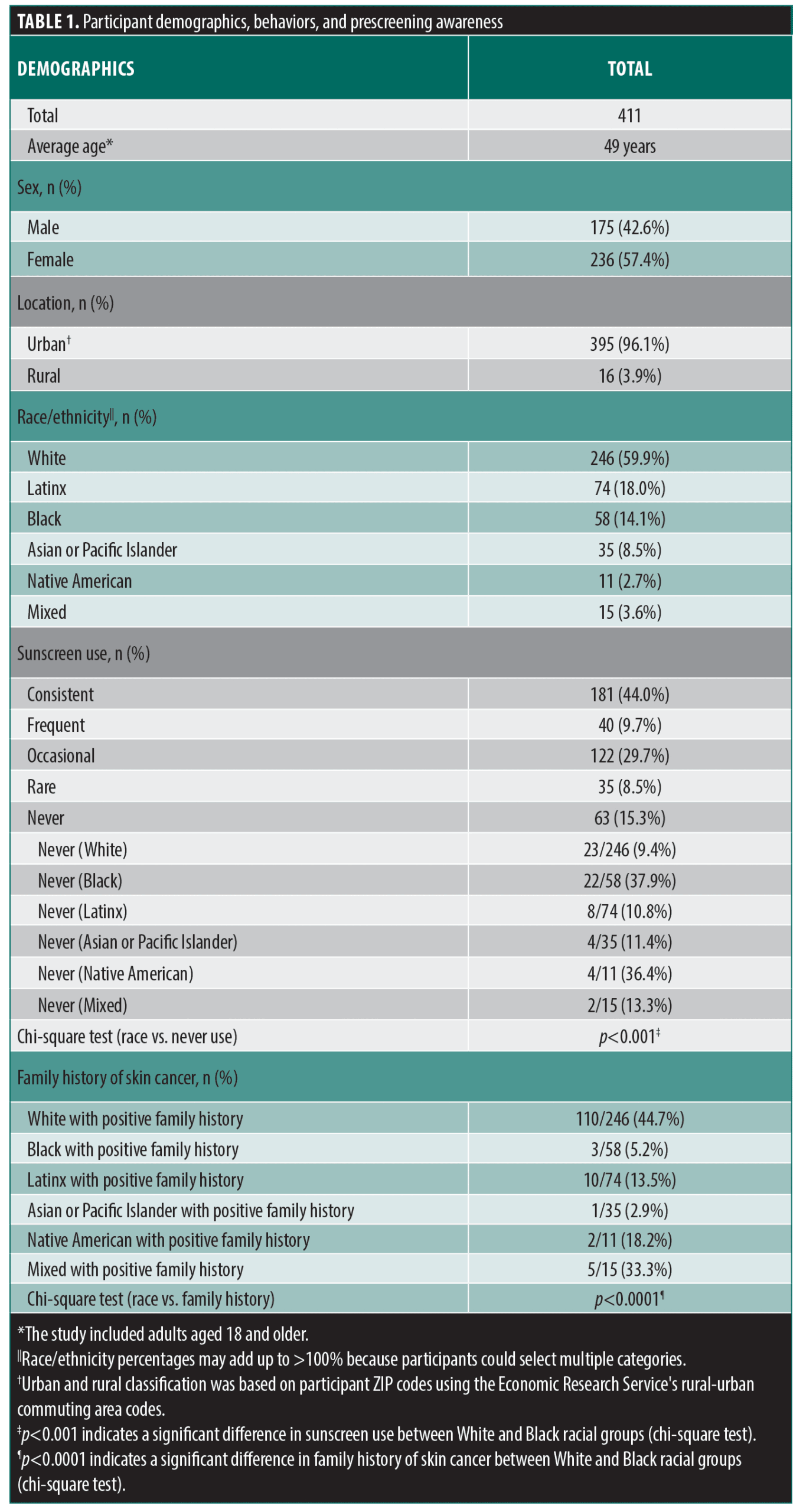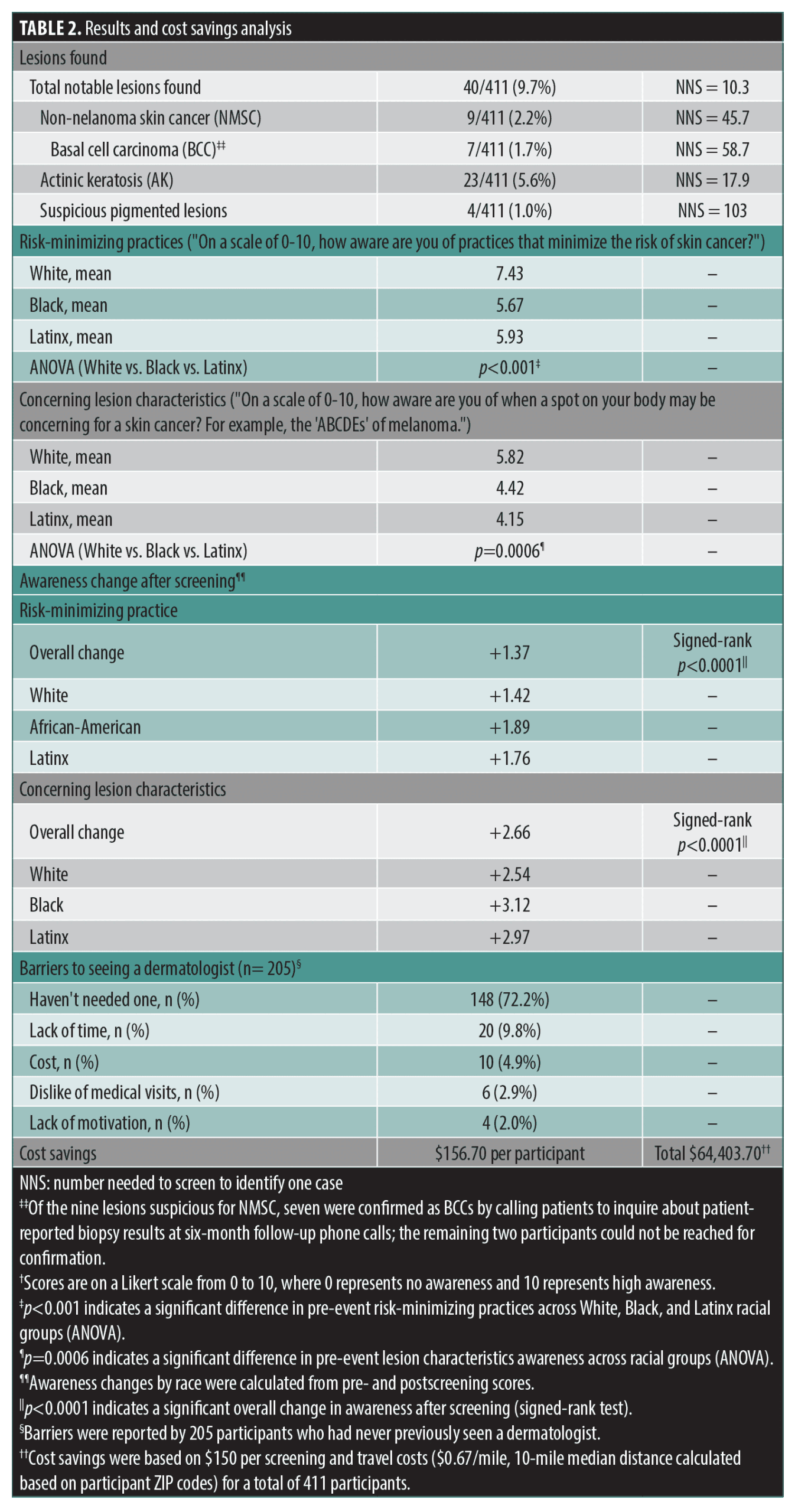J Clin Aesthet Dermatol. 2025;18(10):55–58.
by Anuj Kunadia, MD; Victoria Brito, BA; Jacqueline Oh, BA; Alexandra Smith, BS; Hanxia Li, BS, MS; Daniel Zhao, PhD; and Jeffrey McBride, MD, PhD
Drs. Kunadia and McBride are with the University of Oklahoma Mark Allen Everett Department of Dermatology in Oklahoma City, Oklahoma. Ms. Brito and Ms. Oh are with the University of Oklahoma College of Medicine in Oklahoma City, Oklahoma. Ms. Smith is with Oklahoma State University College of Osteopathic Medicine in Tahlequah, Oklahoma. Mr. Li and Dr. Zhao are with the Department of Biostatistics and Epidemiology at the University of Oklahoma Health Sciences Center in Oklahoma City, Oklahoma.
FUNDING: No funding was provided for this article.
DISCLOSURES: The authors have no conflicts of interest relevant to the content of this article.
Abstract: Objective: The authors sought to evaluate the feasibility, educational outcomes, and cost-savings of free dermatologic screenings at local farmers’ markets and a church in Oklahoma City, Oklahoma. Methods: We piloted six free skin cancer screenings at farmers’ markets and a church in Oklahoma. Exposed areas were examined by dermatology residents under supervision of a board-certified dermatologist. Suspicious lesions were referred. Pre- and postscreening surveys assessed knowledge, sunscreen use, and barriers to care. Demographics and ZIP codes were collected. Follow-up was conducted at 6 months. We estimated cost savings per screening using published visit costs and Internal Revenue Service (IRS) mileage rates. Statistical analysis included paired t-tests, analysis of variance (ANOVA), and chi-square tests (p<0.05). Results: Among 411 adults, 40 participants (9.7%) had notable lesions, including 7 confirmed basal cell carcinomas and 23 actinic keratoses. Awareness of risk-reducing practices and lesion recognition increased significantly postcounseling (both p<0.0001). The most reported barrier to dermatology was lack of perceived need. Estimated cost savings per participant was $156.70, totaling $64,403.70 across all participants. Limitations: Limitations include reliance on self-reported survey data, incomplete follow-up among referred participants, and lack of histopathologic confirmation for all findings. Conclusion: This study shows the feasibility and cost-effectiveness of free skin screenings when paired with local farmers’ markets, which often provide complimentary spaces for nonprofit organizations. These low-cost models may enhance earlier detection and awareness in communities with limited access. Keywords: Skin cancer screening, underserved populations, community health outreach, health disparities, preventive dermatology, cost-effective screening
Introduction
Skin cancer is the most common malignancy in the United States (US), yet access to dermatologic care is not equally distributed across all communities. Patients in underserved areas, particularly those of minority racial or ethnic backgrounds, experience disproportionately worse outcomes due to delayed diagnosis and limited preventive care. Despite national awareness campaigns, persistent disparities exist in both sun protection behaviors and familiarity with warning signs.1,2 Community-based skin screenings offer a promising avenue to bridge this gap, particularly when integrated into trusted local spaces, but data on effectiveness and cost-benefit analysis in nonclinical settings are limited. We piloted six free skin screening programs conducted at local farmers’ markets and a church in Oklahoma City, Oklahoma to assess feasibility, earlier detection outcomes, educational impact, and cost-effectiveness across community demographics.
Methods
From June to October 2024 we conducted five free skin cancer screening events at a local farmers’ market serving a diverse urban population and one at a church serving a predominantly minority population. Across six events, 411 adults participated. Dermatology residents, under the supervision of a board-certified dermatologist, conducted focused skin exams limited to exposed areas. Participants with concerning findings were referred to dermatology clinics for follow-up. Six months after the event, follow-up calls were made to assess whether referred individuals had pursued further evaluation. Some participants could not be reached, declined follow-up, or had not yet completed their referral visits.
Participants completed surveys before and after screening to assess awareness of risk-minimizing practices such as sun safety practices, ability to recognize concerning lesions, sunscreen use, and perceived barriers to dermatologic care. Demographic information, including race, gender, and ZIP code, was collected. Venue resources, including tents, chairs, and tables, were utilized at no cost. Incentives included donated skin care products.
Statistical analyses were performed using paired t-tests for pre- and postcounseling comparisons, analysis of variance (ANOVA) to compare awareness across racial groups, and chi-square testing for categorical variables. Statistical significance was defined as p<0.05.
Results
Among the 411 participants screened, 57.4% were female, 42.6% were male, and the mean age was 49 years. Racial and ethnic demographics included 59.9% White, 18.0% Latinx, 14.1% Black, 8.5% Asian or Pacific Islander, 2.7% Native American, and 3.6% Mixed. The majority (96%) resided in urban ZIP codes, with 4% from rural ZIP codes (Table 1).
Of 411 participants, 40 (9.7%) had notable lesions (number needed to screen [NNS]=10.3): 9 suspected nonmelanoma skin cancers (NNS=45.7) of which 7 were biopsy-confirmed basal cell carcinomas (NNS=58.7); 4 suspicious pigmented lesions (NNS=103); and 23 actinic keratoses (NNS=17.9) (Table 2). While histologic confirmation was not available for all lesions, many patients were connected to appropriate follow-up care.
On a 0 to 10 Likert scale, prescreening awareness of risk-minimizing practices was lower in Black (mean: 5.67) and Latinx (mean: 5.93) participants compared to White participants (mean: 7.43; p<0.001). Similarly, baseline knowledge of concerning lesion characteristics was also lower among Black (mean: 4.42) and Latinx (mean: 4.15) compared to White individuals (mean: 5.82; p=0.0006). Age showed a weak but statistically significant correlation with awareness of concerning-lesion characteristics (r=0.216; p<0.001). Mean awareness scores increased significantly postscreening for both risk-minimizing practices (+1.37 points) and concerning-lesion recognition (+2.66 points; p<0.0001).
Among 205 participants without a prior dermatologist, the most reported barrier was lack of perceived need (72.2%), followed by lack of time (9.76%), and cost (4.88%), with no variation by race (p=0.7087) or rural/urban residence (p=0.5067). Sunscreen use varied by race. A total of 37.9% of Black participants reported never using sunscreen versus only 9.35% of White participants (p<0.001). Family history of skin cancer was significantly more common among White (44.7%) than Black participants (5.2%; p<0.0001). Notably, participants with lower risk-minimizing practice awareness were more likely to report never or rarely using sunscreen (p<0.001).
Cost analysis assumed a $150 average skin cancer screening visit cost2 plus $6.70 in travel expenses based on the Internal Revenue Service (IRS) mileage reimbursement rate of $0.67 multiplied by the 10-mile median distance traveled by participants based on ZIP code. The estimated average cost savings per participant was $156.70, resulting in total projected savings of $64,403.70 across all 411 attendees.
Discussion
This pilot study shows the feasibility and cost-effectiveness of free skin screenings when paired with local farmers’ markets and churches, which often provide complimentary spaces for nonprofit organizations. By leveraging existing infrastructure and community partnerships, we were able to offer dermatologic care at no cost while identifying a substantial number of participants with potentially serious skin conditions. The high percentage of clinically concerning lesions found, particularly in a population with low prior dermatologic engagement, underscores the importance of proactive outreach. Our pilot study shows how low-cost models may enhance earlier detection and awareness in communities with limited access to primary care providers who can screen for skin cancers, as well as dermatologists who can perform more specialized skin checks.3,4
Educational impact was also notable. Baseline knowledge varied significantly by race, reflecting broader disparities in dermatologic education and prevention efforts. Importantly, postscreening surveys revealed significant improvements in participants’ understanding of both risk-reducing behaviors and warning signs of skin cancer. These findings indicate that even a short, structured educational conversation led by dermatology providers can meaningfully improve knowledge and potentially influence preventive behaviors. Education may be especially important, as our survey results suggest that lack of awareness and risk perception may be more important barriers than cost or logistics alone. Community-based models like this one may help close such gaps by offering dermatology services in culturally trusted and geographically convenient locations.
Financially, the cost savings for patients and the healthcare system are compelling. Our findings show infrastructure costs can be minimized through collaboration with existing community venues. With an estimated savings of over $150 per participant, the overall benefit combined with potential early detection of malignancies suggests strong economic feasibility for scaling these efforts.
Limitations. Limitations include reliance on self-reported survey data, incomplete follow-up among referred participants, and lack of histopathologic confirmation for all findings. Selection bias may also have influenced who chose to participate. Expanded multisite studies with full-body skin exams and histological confirmation may provide additional insights.5 Despite these limitations, this study provides a strong foundation for an adaptable and cost-effective framework that could be replicated in other underserved communities or for others seeking to address disparities in skin cancer care through local engagement.
Conclusion
Free skin cancer screenings hosted in public community venues are a feasible, cost-effective approach to improving early detection and patient education, particularly among populations with limited dermatologic access. Integration with trusted local spaces such as farmers’ markets or churches may enhance participation, reduce access barriers, and address longstanding disparities in dermatologic care.
References
- Kerob D, Salah S, Balan D, et al. A comprehensive analysis of global skin cancer incidence and mortality with a focus on dermatologist density and population risk factors. J Am Acad Dermatol. 2024;91(3):AB102.
- Rothstein BE, Gonzalez J, Cunningham K, et al. Direct and indirect patient costs of dermatology clinic visits and their impact on access to care and provider preference. Cutis. 2017 Dec;100(6):405-410.
- Henrikson NB, Ivlev I, Blasi PR, et al. Screening for skin cancer: updated evidence report and systematic review for the US Preventive Services Task Force. JAMA. 2023;329(15):1296-1307.
- Kamat S, Adarwal A, Lavin L, et al. Dermatology in student-run clinics in the United States. JMIR Dermatol. 2024;7:e59368.
- Brown AE, Najmi M, Duke T, et al. Skin cancer education interventions for primary care providers: a scoping review. J Gen Intern Med. 2022;37(9):2267-2279.


